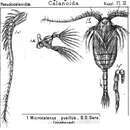en
names in breadcrumbs


Very similar species to M. pygmaeus, some authors argue that it is the same species.
Differences: shorter A1, which reach only the genital segment. Wider third segment of the exopodites of P2, P3 and P4 and wider and coarsely serrated apical spines. The right appendage in P5 in males is equal to 1/3 of the left appendage.
Antarctic, North Pacific, Coast of California, Bering Sea, Sea of Okhotsk, Barents Sea, Arctic Basin
Similar habitat to M. pygmaeus, often impossible to distinguish due to the mixing of the two forms.
Microcalanus pygmaeus
Females: Very small copepods with a characteristic, very round and plump, body shape. Maximum width of the cephalothorax is in the top third, slightly narrowed at the head, which has a triangular shape. The corners of the last thoracic segment carry short rounded projections, which are curved at the base. Apical spines of the exopodites of P2, P3 and P4 widely and coarsely serrated. A1 reaches the genital segment. P5 absent.
Males:
Characteristic body shape even more pronounced than in females. Head has a triangular shape, rounded projections at the corners of the last thoracic segment are very pronounced. P5 asymmetrical - the left appendage is 3 times longer than the left and composed of 6 segments, the last of which is the smallest.
Females: 0.60-0.70 mm
Males: 0.70 mm
Morphology of feeding appendages suggests that this species feeds on phytoplankton, as well as microzooplankton and detritus in deep water layers during winter and early spring.